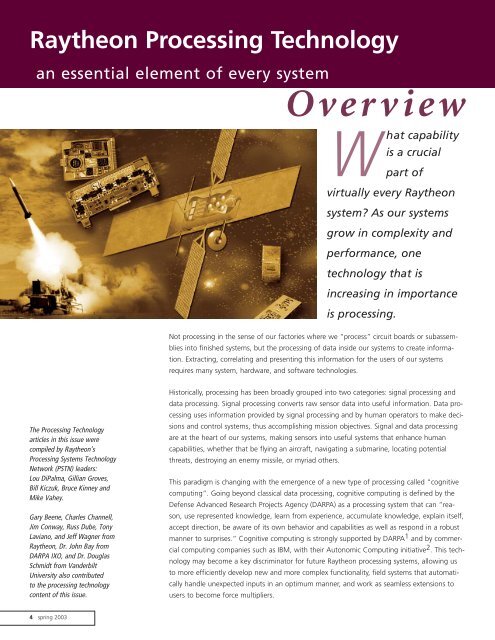Highlights - Raytheon
Highlights - Raytheon
Highlights - Raytheon
You also want an ePaper? Increase the reach of your titles
YUMPU automatically turns print PDFs into web optimized ePapers that Google loves.
<strong>Raytheon</strong> Processing Technology<br />
an essential element of every system<br />
Overview<br />
W<br />
hat capability<br />
is a crucial<br />
part of<br />
The Processing Technology<br />
articles in this issue were<br />
compiled by <strong>Raytheon</strong>’s<br />
Processing Systems Technology<br />
Network (PSTN) leaders:<br />
Lou DiPalma, Gillian Groves,<br />
Bill Kiczuk, Bruce Kinney and<br />
Mike Vahey.<br />
Gary Beene, Charles Channell,<br />
Jim Conway, Russ Dube, Tony<br />
Laviano, and Jeff Wagner from<br />
<strong>Raytheon</strong>, Dr. John Bay from<br />
DARPA IXO, and Dr. Douglas<br />
Schmidt from Vanderbilt<br />
University also contributed<br />
to the processing technology<br />
content of this issue.<br />
4 spring 2003<br />
virtually every <strong>Raytheon</strong><br />
system? As our systems<br />
grow in complexity and<br />
performance, one<br />
technology that is<br />
increasing in importance<br />
is processing.<br />
Not processing in the sense of our factories where we “process” circuit boards or subassemblies<br />
into finished systems, but the processing of data inside our systems to create information.<br />
Extracting, correlating and presenting this information for the users of our systems<br />
requires many system, hardware, and software technologies.<br />
Historically, processing has been broadly grouped into two categories: signal processing and<br />
data processing. Signal processing converts raw sensor data into useful information. Data processing<br />
uses information provided by signal processing and by human operators to make decisions<br />
and control systems, thus accomplishing mission objectives. Signal and data processing<br />
are at the heart of our systems, making sensors into useful systems that enhance human<br />
capabilities, whether that be flying an aircraft, navigating a submarine, locating potential<br />
threats, destroying an enemy missile, or myriad others.<br />
This paradigm is changing with the emergence of a new type of processing called “cognitive<br />
computing”. Going beyond classical data processing, cognitive computing is defined by the<br />
Defense Advanced Research Projects Agency (DARPA) as a processing system that can “reason,<br />
use represented knowledge, learn from experience, accumulate knowledge, explain itself,<br />
accept direction, be aware of its own behavior and capabilities as well as respond in a robust<br />
manner to surprises.” Cognitive computing is strongly supported by DARPA1 and by commercial<br />
computing companies such as IBM, with their Autonomic Computing initiative2 . This technology<br />
may become a key discriminator for future <strong>Raytheon</strong> processing systems, allowing us<br />
to more efficiently develop new and more complex functionality, field systems that automatically<br />
handle unexpected inputs in an optimum manner, and work as seamless extensions to<br />
users to become force multipliers.

















